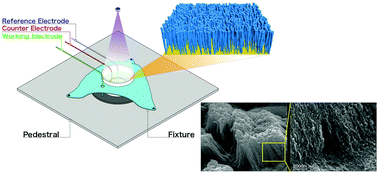UV-assisted, template-free electrodeposition of germanium nanowire cluster arrays from an ionic liquid for anodes in lithium-ion batteries†
Abstract
Germanium has emerged as a promising Li ion battery anode material due to its high theoretical capacity. The in situ growth of Ge nanowires on current collectors (binder-free electrodes) has attracted much attention owing to their good electrical contact, excellent strain accommodation ability, promising material durability and short Li ion diffusion distance. Herein, we report a facile and efficient technique to synthesize Ge nanowire cluster arrays (Ge NWCAs) on nickel foam through an ultraviolet light (UV) assisted, template-free electrodeposition process from 1-ethyl-3-methylimidazolium bis(trifluoromethylsulfonyl) imide ([Emim]Tf2N). As a binder-free anode material, a Ge NWCA electrode exhibits a specific capacity of 1612 mA h g−1 and retains 740 mA h g−1 up to 200 cycles at a current rate of 0.2C. The Ge NWCA electrode affords excellent rate capacity at 0.1C–2C and retains specific capacity as high as 959 mA h g−1 at 2C. Furthermore, the specific capacity well recovers to 998 mA h g−1 when the rate is reduced from 2C to 0.1C. UV assisted ionic liquid electrodeposition might open up a new avenue for the synthesis of semiconductor nanostructures.



 Please wait while we load your content...
Please wait while we load your content...